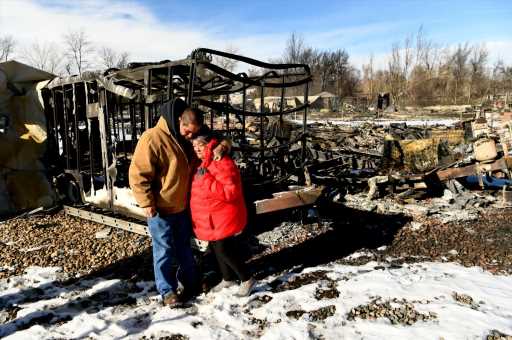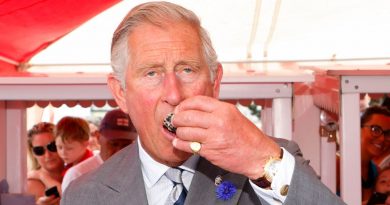The historic heart of Superior, ravaged by Marshall fire, isn’t giving up easily: “Original Town is the only thing I know” – The Denver Post
The 76-year-old matriarch sat at her nephew’s dining room table this week reminiscing about what she affectionately calls “the Chavez compound,” home to generations who grew up on the same block of Original Town Superior, now burned to the ground.
As Elsie Chavez spoke, a parade of visitors — family, neighbors, friends — streamed in bearing crockpots of food, trash bags stuffed with new and used clothing, gift cards, cash and prayers.
Nobody bothered knocking.
Over the course of a couple of hours, countless Coloradans burst through the front door of Ryan Chavez’s Westminster residence and made the rounds hugging members of the sprawling family in a home abounding with “I love you’s” and kisses on the cheek.
“It feels like someone died,” Elsie Chavez said.
While nobody in the Chavez family lost their life in late December’s devastating Marshall fire, which incinerated more than 1,000 homes in unincorporated Boulder County and suburban Superior and Louisville, they are mourning the loss of the Chavez compound, five homes on the same block where generations of this family built their lives.
The Chavezes, like other pillars of Original Town, are descendants from the original coal mining families whose hard work and determination gave life to the small town, then and now.
Members of this tight-knit family — Grandma Elsie Chavez, Ted Chavez, Carmen Aranda and Loretta Chavez — sift through the ashes of history in search of anything to tie them back to their roots to Superior’s Original Town.
“You bet we have an attitude”
Superior is about four square miles of mostly housing with some retail nestled between Boulder and Broomfield. About 14,000 residents called the town home pre-fire, with the largest contingency living in the sprawling Rock Creek subdivision, developed in the late 1980s, said Larry Dorsey, chair of the Superior Historical Commission.
Coal miners founded Superior in 1896 and, by 1900, about 135 people lived in the Coal Creek Valley, which featured a general store, candy and fruit shop, multiple saloons, the Miner’s Trading Company, a boarding house for unmarried miners and a house for “working girls,” Dorsey said.
The mine was active for about 50 years, he said, and put out nearly 4 million tons of coal during its time.
The coal mine closed in 1945, but some of the families descended from the original residents of the mining town never left, Dorsey said. The neighborhood, declared Original Town by its residents as a reminder that they started it all, sits west of northbound McCaslin Boulevard and south of Marshall Road.
The historic neighborhood was ravaged by the Marshall fire.
The latest damage assessment by Boulder County lists 378 homes in Superior among the total 1,084 destroyed by the Marshall fire. It’s not clear yet what percentage of Superior’s losses came in Original Town, but Superior Mayor Clint Folsom said the damage to that neighborhood was catastrophic.
“Just from my own driving around down there during the fires and then the day after, it is just devastating,” Folsom said. “There’s a couple of homes remaining, but the majority of homes in there are gone.”
Over the years, development boomed around Original Town — master-planned communities, a strip mall packed with chain restaurants and big-box stores.
The age-old tensions between old and new, wealth and the lack thereof, historic and modern creeped in, said Original Town resident Gladys Forshee, who lost her home in the fire.
“We’re Original Town and, yes, we have an attitude,” said Forshee, 80. “You bet we have an attitude, and we’re goddamn proud of it.”
Forshee owned her Original Town property for 50 years and said she doesn’t know what she’s going to do now that her home burned, but that the members of her scrappy community are “like glue” and will figure it out just like they always have.
“We understand it’s the 21st century,” Forshee said. “We understand new people are going to come in, but don’t come in and think you’re God’s gift to save us because you’re not.”
“Little town started growing”
Elsie Chavez’s grandfather was an Original Town coal miner. The 76-year-old grew up in Original Town, raised her kids there and now her children are raising their children there.
“The neighbors were family,” said Ted Chavez, Elsie Chavez’s son, who spoke while on hold with his insurance company searching for information on how to proceed after his Original Town house burned down, too.
“The neighborhood kids would get spanked together. When it was dinner time, the moms would holler ‘Time to eat!’ out the door and everyone would come inside. We used to all play baseball together, and if we hit a ball through someone’s window, they’d tell you to come back next weekend and do chores to pay it off. That’s how the neighborhood was.”
Soon, the neighborhood with dirt roads and well water started changing. The roads got paved. City water and sewage was installed.
“The little town started growing around us,” Elsie Chavez said.
The Rock Creek subdivision entered the scene in the late 1980s.
“That’s when things really started to change because Original Town and Rock Creek were quite different socioeconomically,” Dorsey said.
The Chavez family stayed through it all, and when new neighbors moved in, they said they welcomed them to the Original Town family.
“One of the things really coming to a head before this fire was what’s going to happen with the longtime people whose property goes back decades, maybe even back to the early 1900s, when developers are coming in, buying up a chunk of land, dividing it up and putting houses on it,” Dorsey said. “The people who live there get pressured to sell and then where do they go? Gentrification was really coming to a head.”
The Chavez family didn’t have plans to go anywhere.
Birthday parties, cookouts, holidays, rallying when an elder of the neighborhood died. The thick-as-thieves neighbors wanted to show newcomers the true spirit of Original Town — a spirit the Chavez family, Dorsey and Folsom said could never be touched by the flames.
A vow to rebuild
While neighborliness remained intact, unfortunately, Original Town buildings and properties were no match for the fast-moving suburban wildfire.
Dorsey and Folsom lamented the loss of an Original Town museum — one of the genuine mine camp company houses the Superior Historical Commission and town leaders transformed into an educational and historical space about a decade ago.
The museum was made into a replica of what the small home would have looked like at the time and an added basement held historical artifacts, including miner’s attire and safety gear, coal mining apparatus and a kitchen table of one of the original residents.
“It’s all gone now,” Dorsey said. “We’re just crushed by that.”
As members of the Chavez family returned from appraising the damage done to their Original Town houses on Tuesday — a total loss across the board — they trickled into Ryan Chavez’s home clutching tiny treasures they pulled from the rubble.
Loretta Chavez found a necklace she bought for Elsie Chavez’s birthday. Elsie Chavez found a rosary. A few angel statues were still standing, surrounded by ash.
Elsie Chavez kicks herself for not thinking to grab the shelves of photo albums documenting the family’s life on the Chavez compound, but said they only had minutes to escape before burning embers started raining down on them.
“We lost our things we can’t replace, but we still have our memories,” Ted Chavez said. “We have good friends, neighbors and family. We have each other.”
The most devastating wildfire in Colorado history will not be the end for Original Town, Ted Chavez said.
The family vows to rebuild.
“Original Town is the only thing I know,” Elsie Chavez said. “I’ll move when the good Lord says it’s time. With this tragedy, I think the neighborhood is going to come back stronger and supporting each other.”
Source: Read Full Article










